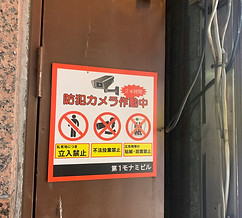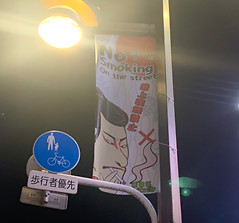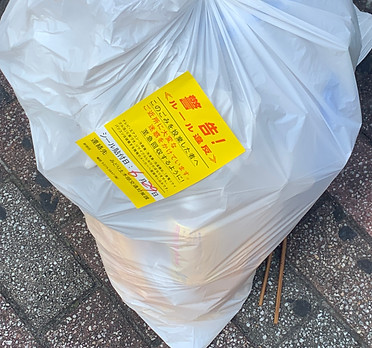
Signboards & Announcements
Signs
by Yui
Physical Traits
At first glance, what types of signs are in Kabukicho?
From what I noticed, I saw many different types of signs: banners on street flag poles, flags, posters, electronic billboards, cones, and signboards in a variety of shapes.
Let us take a look at these signs
Flag/hata
These are very unnoticeable, usually blends in with the surroundings. It is on the sides of buildings or streets. It is kind of hard to see as it is flimsy and quite thin. It attaches and blends into the bulkier sign behind it.

Poster
usually on fences or inside a building. This images shows a poster on a door of a electric room or storage. It needs the support of a different object to be apparent to the audience.

Independent signs
These are independent signs that do not rely on other objects to serve its purpose like the poster. This one is big and heavy so that it could physically block off unwanted things, in this case a car

Cones
Signs with poles
These are relatively bigger than the poster, it is stood next to an announcement pole or normal pole.

Street flag pole / banner
these banners are on street lights, usually with visual images. Since it is by a street light it is easier to see and read what is on the banner.

These are orange cones, which sometimes can be seen with posters like here. Similar to the independent signs, it physically blocks and prevents certain things or people. In this case, it is preventing cars from parking in that area.

These are very entertaining with sound and visuals. Our group has only seen this by the wait by Shinjuku Alta and a few smaller electronic billboards in the station. This specific electronic billboard attracts the audience as they are waiting for the streetlight to change.
Electronic billboards / signs

Content of signs
So as we see the signs and posters all over Kabukicho, what exactly are they about?
Signages are used all over the world to send a message.
The signs we see typically in vary from street signs, restaurant signs, 18 and up signs, and etc., but in this section we will be focusing on the contents of police and warning signs.
Warning signs, in particular, are used to inform and warn people on how to behave in the city.
This can be seen, especially in Kabukicho too as it is known to be one of the most dangerous places in Japan. As the groups, such as the Kabukicho Renaissance and the Kabukicho Town Management, and the Shinjuku City Hall teamed up in hopes to make Kabukicho a safer and cleaner city, there are a variety of messages they have put up in hopes to reach their goal. The messages that concern the way an individual should act, in order to create a cleaner city can be seen in the no littering, no smoking, rule breaking warning, and other signs.
For a Cleaner City
🚬No smoking🚭
The smoking culture in Japan has been an on-going issue that Tokyo has been trying to change. In a year, according to the Bureau of Social Welfare and Public Health, about 15,000 people die from secondhand smoking. In order to change this, Tokyo created a law that restricted and regulated indoor smoking in places such as restaurants, in April, 2020. From then on, it has limited smokers from smoking in indoor facilities, so where would these people smoke at? You might see some people using the smoking area right by the east exit of Shinjuku, but if you have been in this area of Shinjuku, I’m sure many of you have seen people smoking in non designated areas outside. In order to prevent this, the city has put up no smoking signs. By doing so, Shinjuku City hopes to lessen the number of deaths from secondhand smoking and create a cleaner, healthier city.
🗑️Littering and Rule Breaking🚯
Although Japan is known to be one of the cleanest countries in the world, walking into Kabukicho might be a surprise, especially during the night or the next morning of a weekend. In Japan, there are almost no public trashcans. Despite that, when walking around popular places such as Shibuya or Kabukicho, it can not be compared.
As seen in the pictures below, there are a few signs that send the message to correct individuals’ actions of littering, in order to create a cleaner version of Kabukicho.
“a new ‘empire of signs’ instructing visitors in every kind of behaviour (mostly what not to do) and a purified, superficial beauty typical of the new aesthetic of control”
(Wood and Abe 2011)
As Wood mentions “new aesthetic of control,” it can be seen through the signs and the Kabukicho Renaissance project as one of its goals are the Clean Operation Project, in which focuses not only on the safety and security, but also the environmental beautification focus.
Then in the next two pictures we see that there are trash left in places that were not allowed, so a specific group from the government placed these small warning notices that say “rule violation” or “breaking the rules”
Through these do-not litter and breaking rules signage, it can help create a more aesthetic Kabukicho and individual, with the help from the Kabukicho Renaissance project.




Describe your image

Describe your image

Describe your image

Describe your image
For a Safer City
Japan is also known to be one of the safest countries in the world, ranking 12th place on the Global Peace Index and 5th in Societal Safety and Security section of the GPI’s indicator (Yamatogokoro 2021). Even then, Kabukicho is one of the places that most people try to steer clear from as Kabukicho is known to be the red-light district.
In hopes in making Kabukicho a safer environment for all people, the Kabukicho Renaissance, the police, and the Shinjuku Ward Office are using these types of posters or signs below.
These signs were found both inside the Shinjuku station and out in streets of Kabukicho. Let’s take a closer look into each.
On the left, from the three pictures, we can see the different police signs such as “getting rid of violence groups” or scam awareness posters.
Here we can see an official sign that declares that this is a spot or building that the police would come by from time to time as the police would do their patrolling, protecting the city. By having such sign, it will remind people to behave appropriately.
This sign brings awareness and warns us, visitors, to not follow the catchs or any store recruiters. This sign is definitely important for newcomers.
As seen earlier, this independent sign prevents cars from entering, creating a safer environment for the people walking in Kabukicho.



Mode Analysis
As we have seen in the previous sections, there are signs that are just words with colors, ones with maps, and ones with illustrations as the main focus. Let us take a look into a few examples to deepen our findings.
Illustrations
Here we have the no smoking banner from above, where we can see that it is an illustration focused signage. It has a cartoon of a kabuki actor who is smoking with a stern glare. Since the banner is high up, not many people would look up just for a warning sign with a lot of words, but by having a cartoon drawing of something interesting like a kabuki actor smoking, it can spark a person’s interest. Given that it is a banner with Japanese aesthetics and that the biggest words on there is English, it can be assumed that the target audience would be foreigners and tourists


“On these poles a warning sign of surveillance in operation is hung, which enhances the individual’s awareness of being monitored […] Fostering an awareness of being monitored is an integral part of surveillance and a mechanism of disciplining individual bodies” (Nishiyama 2018).
Here is a security camera sign with different images letting us know that our actions are being monitored and recorded. Such details gives us viewers a sense of fear of doing something that is considered inappropriate in this area.
“a color that stands out at a glance” for the main color, which is yellowish orange. The antenna on the head represents the role of the police to detect what is going on in society”
(the Japan Times n.d.)
Here in this poster from a different section, we can see the cute little characters taking up most of the poster. This character is actually the Tokyo police mascot, named Peopo-kun, a yellowish orange character that was created so to stand out at one glance according to the Japan Times.
Not only does the yellowish orange mascot stand out, but the background colors are very unusual to see for a warning / safety sign.

Through these fun illustrations, the Shinjuku Renaissance’s goal to the creation of new cultures, redlight to an entertainment city, can be seen in place as it fits the aesthetics of the envisioned new and fun entertainment city, Kabukicho.

Wording / phrasing
This nonsmoking sign is quite unique as it not only tells us to not smoke, making smoker users feel cornered and trapped as the smoking regulations became stricter, but in smaller words, it tells the reader where to smoke. By adding this in, it makes the reader feel a bit more welcomed in a sense to smoke, but smoking respectfully.
The sign says “No smoking, place use the smoking area. The smoking area is located next to the JR station”
-some words such as 'Deadly' and 'Danger' are attributed a higher arousal strength than words such as 'Attention' and 'Note' (Edworthy et. al. 2003)
Here, it says 警告 (ルール違反)or “warning! (breaking the rules)” , which seems less effective when put together, but the reason why the word 警告 is written bigger is because it kind of gives off the similar feeling of if it were to say “deadly” and “danger.” Though, the word ルール違反 “breaking the rules”, especially with the parenthesis, does give the similar feeling of if it were to say “attention” and “note.” Through this example, we can see the difference and importance of how strong a word or words are.

Conclusion
Here in this section, we can see the efforts made by the Kabukicho Renaissances Council, the Kabukicho Town Management, and other authorities. From the different types of physical traits, content, and mode analysis, the efforts in order to produce a cleaner and safer city can be understood.
Sections
Signboards & Announcements
